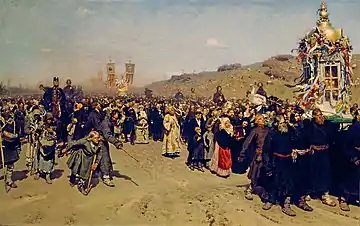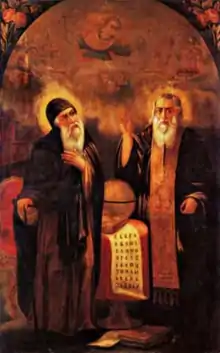Trilingual heresy
In Slavic Christianity, the trilingual heresy or Pilatian heresy[1][2] (less pejoratively trilingualism) is the idea that Biblical Hebrew, Greek, and Latin are the only valid liturgical languages or languages in which one may praise God. Trilingualism was rejected in the 850s by Saints Cyril and Methodius, Byzantine brothers and missionaries who introduced a Christian liturgy in the vernacular of their Slavic converts, a language now called Old Church Slavonic.

Origins
The idea originates as Old Church Slavonic Трьѧзычьници́,[1] (Trĭẽzyčĭnici), literally meaning "threefold paganism" rather than "threefold heresy".[1] It appears as a neologism in several chapters of a contemporary hagiography of Cyril (then named Constantine), most prominently when recounting a disputation in Venice in AD 867 while he and Methodius were en route to the Holy See, bringing relics of Pope Clement I and hoping to resolve a jurisdictional dispute in Great Moravia with Latin Rite missionaries sent by the Bishop of Salzburg.[3] In St. Mark's Square, hostile clerics (branded "Latin accomplices" of the devil[1]) "assembled against [Constantine] like ravens against a falcon and raised the trilingual heresy".[4] Constantine defeated them by citing scripture and by pointing to the many precedents of Oriental Orthodox churches with vernacular liturgy.[4][5] Elsewhere Constantine points out that Pontius Pilate (hence "Pilatian" heresy) used Hebrew, Greek, and Latin for the inscription on Christ's cross.[1] In Rome Pope Adrian II duly approved the Slavonic liturgy.[3] A generation later, Chernorizets Hrabar's defence of the Glagolitic script used to write Old Church Slavonic likewise deprecates trilingualism on the basis that the Slavs would never have been converted if their own language had not been used.[6]
Historical critiques

Papal edicts of 870 and 880 endorsed Slavonic liturgy, whereas others of the same era do not.[7] Ihor Ševčenko points out that Isidore of Seville had written that Hebrew, Greek, and Latin were the languages of "sacred law".[7] Adrian II's support for Cyril and Methodius has been interpreted as motivated a desire to check the influence of the Bishop of Salzburg,[8] or avoid a dispute with the Ecumenical Patriarch of Constantinople to whom Cyril and Methodius were responsible.[9] A converse suggestion is that trilingualism was invented by the Salzburg lobby to attack Cyril and Methodius.
Some historians regard trilingualism as a straw man invented by Orthodox supporters of autocephaly or national churches but never actually promoted by the Papacy or Constantinople.[10] Riccardo Picchio regards the Venetian story as apocryphal.[11][12] The Council of Tours 813 had mandated homilies in the vernacular (Romance or German). For other parts of the Catholic Mass, widespread use of the vernacular rather than Latin came after the Second Vatican Council adopted Sacrosanctum Concilium in 1963. Ševčenko sees the Byzantine church as on the one hand grudging in allowing for vernacular churches, but on the other hand characterising trilingualism after the East–West Schism as an error of the Western church.[13]
See also
References
Sources
- Ševčenko, Ihor (1964). "Three Paradoxes of the Cyrillo-Methodian Mission". Slavic Review. 23 (2). doi:10.2307/2492932. ISSN 0037-6779. JSTOR 2492932.
Citations
- Jakobson, Roman (2010). "Sketches for the History of the Oldest Slavic Hymnody: Commemoration of Christ's Saint and Great Martyr Demetrius". Comparative Slavic Studies. The Cyrillo-Methodian Tradition. Walter de Gruyter. p. 297. ISBN 978-3-11-086389-5. Retrieved 16 March 2020.
- Betti, Maddalena (2013). The Making of Christian Moravia (858-882): Papal Power and Political Reality. Brill. p. 226. ISBN 978-90-04-26008-5. Retrieved 16 March 2020.
- Pope Benedict XVI (15 September 2009). "Saints Cyril and Methodius". Adoremus Bulletin. Retrieved 16 March 2020.
- Hunt, Robert A, ed. (2014). "Part 2, Chapter 6, Number 10: The Life of Constantine". The Gospel Among the Nations: A Documentary History of Inculturation. Orbis. ISBN 978-1-60833-390-5. Retrieved 16 March 2020.
- Koumoulides, John T. A. (1987). Greek Connections: Essays on Culture and Diplomacy. University of Notre Dame Press. p. 53. ISBN 978-0-268-01014-0.
- Leeming, Henry (2001). Historical and Comparative Lexicology of the Slavonic Languages. PAN. p. 76. ISBN 978-83-86726-99-8.
- Ševčenko 1964 p.222, esp. fn.8
- Roland, Ruth A. (1999). Interpreters as diplomats : a diplomatic history of the role of interpreters in world politics. Ottawa: University of Ottawa Press. p. 27. Retrieved 16 March 2020.
- Fletcher, R. A. (1998). The barbarian conversion. New York: Henry Holt. pp. 354–356. ISBN 0 8050 2763 7. Retrieved 16 March 2020.
- Thomson, Francis J. (1992). "SS. Cyril and Methodius and a Mythical Western Heresy: Trilingualism". Analecta Bollandiana (110): 67–122.; cited in Ivanov, Petko (1996). "The Controversial Saints: Representations of Cyril and Methodius in Modern Slavic History: Chronology and Theses". Slavic Studies Faculty Publications. Connecticut College (11). Retrieved 16 March 2020.
- Picchio, Riccardo (1972). "Questione della lingua e Slavia cirillometodiana". Studi sulla questione della lingua presso gli Slavi (in Italian). Rome: Edizioni dell'Anteneo. pp. 67–86.; cited in
- Butler, Francis (1995). "The Representation of Oral Culture in the Vita Constantini". The Slavic and East European Journal. 39 (3): 379–380, fn.13. doi:10.2307/308238. ISSN 0037-6752. JSTOR 308238.
- Ševčenko 1964 pp.228–229, esp. fn.30
